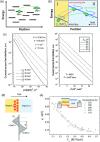Interface Engineering in Organic Electronics: Energy-Level Alignment and Charge Transport
- PMID: 40212417
- PMCID: PMC11935847
- DOI: 10.1002/smsc.202000015
Interface Engineering in Organic Electronics: Energy-Level Alignment and Charge Transport
Abstract
Organic light-emitting diodes (OLEDs) and organic solar cells are new members of trillion-dollar semiconductor industry. The structure of these devices generally consists of a stack of several organic layers sandwiched between two electrodes. The electronic processes such as the energy-level alignment at and charge transport across these interfaces play a key role to the overall performance of the organic devices. Thus, interface physics is important for design and engineering of organic devices. Herein, recent progress in energy-level alignment at and charge transport across organic interfaces is reviewed. In addition, basic material physics of organic semiconductors such as energy levels, energy disorder, and molecular orientation is introduced. Recent progress in theories and experiments on energy-level alignment at and charge transport across molecular heterojunctions is then discussed. Case studies of applying interface physics for guiding fabrication of ideal devices are also provided.
Keywords: charge transport; electronic properties; energy-level alignment; organic interfaces; organic optoelectronics.
© 2020 The Authors. Published by Wiley‐VCH GmbH.
Conflict of interest statement
The authors declare no conflict of interest.
Figures














Similar articles
-
Mapping Energy Levels for Organic Heterojunctions.Adv Mater. 2017 Jun;29(24). doi: 10.1002/adma.201700414. Epub 2017 Apr 24. Adv Mater. 2017. PMID: 28436573
-
Energy level alignment at planar organic heterojunctions: influence of contact doping and molecular orientation.J Phys Condens Matter. 2017 Apr 5;29(13):133001. doi: 10.1088/1361-648X/aa5a6c. Epub 2017 Feb 14. J Phys Condens Matter. 2017. PMID: 28195076
-
Exploring the energy landscape of the charge transport levels in organic semiconductors at the molecular scale.Acc Chem Res. 2013 Feb 19;46(2):434-43. doi: 10.1021/ar300198p. Epub 2012 Nov 9. Acc Chem Res. 2013. PMID: 23140088
-
Recent Progress on Perovskite Surfaces and Interfaces in Optoelectronic Devices.Adv Mater. 2021 Jul;33(30):e2006004. doi: 10.1002/adma.202006004. Epub 2021 Jun 17. Adv Mater. 2021. PMID: 34145654 Review.
-
Alignment of Organic Conjugated Molecules for High-Performance Device Applications.Macromol Rapid Commun. 2022 Jul;43(14):e2100931. doi: 10.1002/marc.202100931. Epub 2022 May 1. Macromol Rapid Commun. 2022. PMID: 35338681 Review.
References
-
- Liu S., Yuan J., Deng W., Luo M., Xie Y., Liang Q., Zou Y., He Z., Wu H., Cao Y., Nat. Photonics 2020, 14, 300.
-
- Zhu L., Zhang M., Zhou G., Hao T., Xu J., Wang J., Qiu C., Prine N., Ali J., Feng W., Gu X., Ma Z., Tang Z., Zhu H., Ying L., Zhang Y., Liu F., Adv. Energy Mater. 2020, 10, 1904234.
-
- Zhou Z., Liu W., Zhou G., Zhang M., Qian D., Zhang J., Chen S., Xu S., Yang C., Gao F., Zhu H., Liu F., Zhu X., Adv. Mater. 2020, 32, 1906324. - PubMed
-
- Xu X., Yao Y., Shan B., Gu X., Liu D., Liu J., Xu J., Zhao N., Hu W., Miao Q., Adv. Mater. 2016, 28, 5276. - PubMed
-
- Wang C., Zhang X., Dong H., Chen X., Hu W., Adv. Energy Mater. 2020, 10, 2000955.
LinkOut - more resources
Full Text Sources
